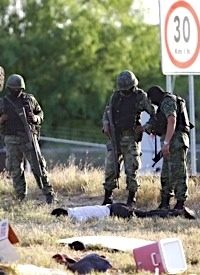
Sealing off the surrounding streets with motor vehicles on Wednesday, April 21, several hooded gunmen burst into a 17-story Holiday Inn and another hotel across the way in the northern city of Monterrey, Mexico’s industrial hub, which has seen a surge in violence recently. Nuevo Leon state attorney general Alejandro Garza y Garza said that between 20 and 30 gunmen abducted four guests, a receptionist, and possibly a security guard. Some reports put the amount of assailants at 50. Because of the vehicles blocking the area, police could not immediately get to the scene.
This attack was brazen even by Mexican standards. One official told the Wall Street Journal, “The Gulf Cartel is finishing off the Zetas. It’s total war.”
A handcuffed man was with the gunmen and led them to the fifth floor where the assailants stormed room 517. When the Asian guest they found there was not the person they wanted, the kidnappers left him to further scour about seven other 5th floor rooms. They appeared to seek specific targets.
According to Garza y Garza, the kidnappers eventually headed across the street to the Hotel Mision where they abducted the receptionist.
Among the four abducted guests were three men who registered at the Holiday Inn as businessmen from Mexico City, and a woman registered as a resident of the border city of Reynosa, across from McAllen, Texas.
The attorney general added that the attackers stole a computer containing the Holiday Inn’s hotel registry as well as the hotel’s security videos.
“A lot of what we’re going through right now is part of a readjustment among cartels,” Garza y Garza told a news conference in Monterrey. He believed that organized crime was likely behind the attacks.
It still is not clear exactly who these kidnap victims are or what the precise motivation for the assault was.
The U.S. Consulate in Monterrey repeated its warning to U.S. citizens to be wary of the violence in the state of Nuevo Leon where the raid took place. It also denied reports that one of those kidnapped from the Holiday Inn was an American woman.
Drug cartels have escalated their battling presence in Monterrey, and have tried to elude police and the military by using stolen cars and at times burning vehicles to block roads.
Regarding America’s interest in this desperate situation, The New American article from last month, “Escalating Chaos on Our Border,” warned that this ongoing drug war is not simply Mexico’s problem. In it, William F. Jasper observed:
?Mexico’s narco-terror doesn’t stop at the Rio Grande; the drug cartels’ ultra-violent methods have made their way onto the streets of America, where a network of literally hundreds of thousands of Mexican gang members operate, often with near impunity, in the “hoods” of Los Angeles, Phoenix, Houston, Atlanta, San Diego, Fresno, and dozens of other cities throughout the United States.?
According to the FBI, “About 20,000 violent street gangs, motorcycle gangs, and prison gangs with approximately 1 million members are criminally active in the U.S. today.” A large percentage of those gangs and gang members is affiliated with, and is subservient to, the two major rival Mexican gangs, the Mexican Mafia and Nuestra Familia.
Figures from the U.S. Immigration and Customs Enforcement (ICE) show that of the 6,559 violent gang members arrested by ICE from 2005-2007, the vast majority (76 percent) came from just two countries — Mexico and El Salvador. The notoriously violent El Salvadoran gang Mara Salvatrucha (also known as MS-13) gives allegiance to the Mexican Mafia, so it can be considered, in effect, a Mexican gang. These gangs constitute a foreign occupying army in many of our communities. And the frightful havoc being wrought south of our border provides a glimpse of what we can expect to unfold here if they are allowed to prosper with impunity and to continue bringing in new recruits.
Simply locking up more of them in prison is not the answer; the Mexican Mafia already has too much power over much of the prison system in California. A recent investigative report by San Diego’s Channel 10 television station lends support to charges that the top Mexican Mafia members incarcerated in some California jails and prisons not only run criminal operations on the street from their jail cells, but also virtually “run” the prisons as well. Reports by Channel 10 on February 8 and 9 of this year focused on “Andrea,” a highly placed member of the Mexican Mafia who became an informant for the FBI. Andrea, who helped take down some of the top Mexican Mafia kingpins, says she ran many of the prisons for the gang leaders, paying huge sums to crooked guards, bail bondsmen, and lawyers, who would smuggle drugs and other contraband in to the imprisoned gangsters, as well as deliver their orders to gang lieutenants on the outside.
More alarmed voices are beginning to be raised, insisting that another approach be taken to this never-ending and ever-growing danger.
Photo: Soldiers stand over the body of a suspected hit man lying next to his overturned vehicle after a shootout on the outskirts of Monterrey, on March 30, 2010.: AP Images



